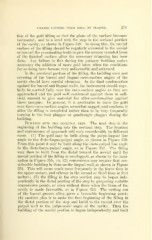Page 571 - My FlipBook
P. 571
FILLING CAVITIEH WITH GOLD, BY CLASSES. 271
tion of the gold filling so that the plane of the surface becomes
horizontal; and to a level with the step in the occlusal portion
of the cavity, as shown in Figure 349. In doing this, the mesial
surface of the filling .should be regularly extended to the mesial
or toward the proximating tooth to give the proper rounded form
of the finished surface after the necessary trimming has been
done. Any failure in this during the primary building makes
necessary the addition of more gold later, when the conditions
for so doing have become very unfavorable and awkward.
In the proximal jjortion of the filling, the building over and
covering of the buccal and lingual cavo-surface angles of the
cavity should have careful attention. In the final condensation
against the buccal and lingual walls, the instrument should regu-
larly be carried fully over the cavo-surface angles as they are
approached and the gold well condensed against them in suffi-
cient amount to give material for after-condensation against
these margins. In general, it is preferable to leave the gold
over these cavo-surface angles somewhat ragged, and condense it
after the filling is completed rather than to be very frequently
turning to the foot plugger or quadrangle plugger during the
building.
Building into the occlusal step. The next step is the
beginning of the building into the occlusal step. The location
and convenience of approach will vary considerably in different
cases. (1) The gold may be built along the pulpo-lingual line
angle to the disto-linguo-pulpal angle, as shown in Figure 350.
From this point it may be built along the disto-pulpal line angle
to the disto-bucco-pulpal angle, as in Figure 352. The filling
may then be built from the distal toward the mesial until the
mesial portion of the filling is overlapped, as shown by the lami-
nation in Figure 355; or, (2) convenience may require that con-
siderable building be done on the lingual wall, as shown in Figure
351. This will occur much more frequently in the lower than in
the upper molars, and oftener in the second or third than in first
molars; (3) the filling in the step portion may be begun inde-
pendently in the distal portion of the step by preparing suitable
convenience points, or even without these when the form of the
cavity is made favorable, as in Figure 353. The cutting out
of the buccal groove often gives a favorable beginning point;
(4) another plan is to make the first beginning of the filling in
the distal portion of the step and build to the mesial over the
pulpal wall to the pulpo-axial angle of the cavity. Then the
building of the mesial portion is begun independently and built


